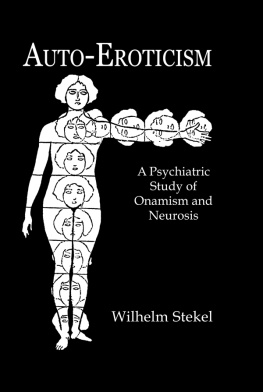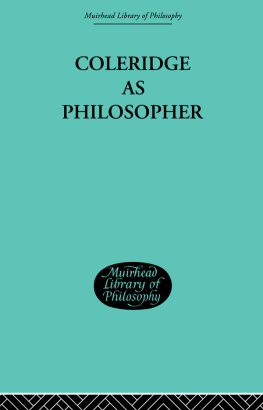AUTO-EROTICISM
When this work was first published in the first half of the last century, sexology and the unprejudiced study of sexual activity was in its infancy. In his study of human sexual behaviour, Kinsey was able to state that the majority of human beings had masturbated at one time or another but to us today this seems quite an astonishing statement to have had to make.
The study of human sexuality was surrounded by ignorance and superstition, and the medical profession was regretably the worst offender and the most ignored. In such a climate, Dr. Stekels book was a revelation much ahead of its time.
AUTO-EROTICISM
A Psychiatric Study of Onanism and Neurosis
Wilhelm Stekel

First published in 2004 by
Kegan Paul International
This edition first published in 2011 by
Routledge
2 Park Square, Milton Park, Abingdon, Oxon, OX 14 4RN
Simultaneously published in the USA and Canada
by Routledge
711 Third Avenue, New York, NY 10017
Routledge is an imprint of the Taylor & Francis Group, an informa business
Kegan Paul, 2004
All rights reserved. No part of this book may be reprinted or reproduced or utilised in any form or by any electronic, mechanical, or other means, now known or hereafter invented, including photocopying and recording, or in any information storage or retrieval system, without permission in writing from the publishers.
British Library Cataloguing in Publication Data
A catalogue record for this book is available from the British Library
ISBN 10: 0-7103-0894-9 (hbk)
ISBN 13: 978-0-7103-0894-8 (hbk)
Publishers Note
The publisher has gone to great lengths to ensure the quality of this reprint but points out that some imperfections in the original copies may be apparent. The publisher has made every effort to contact original copyright holders and would welcome correspondence from those they have been unable to trace.
by
EMIL A. GUTHEIL, M.D.
We usually take medical progress for granted and are inclined to forget that at the beginning of each advance stands an individual, an independent thinker and intuitive observer who dares to disagree with the existing views and to expose himself to the animosity of his conservative contemporaries.
Today we consider the aseptic management of obstetrical deliveries as self-evident and we tend to forget that there was a time when an individual, Semmelweiss, working at an obstetric clinic in Vienna, dared to challenge his profession with the bold pronouncement that it was the physician himself who with his unsterile hands was carrying the puerperal infection and death to the women in childbirth. Ridiculed and ostracized at first, Semmelweiss later was rightly referred to as the Savior of Mothers.
Conditions in the field of sexology were also controlled by ignorance. Today, when Kinsey in his study is able to state that the majority of human beings have masturbated at one time or another; when the problem of autoerotism represents a topic of frank discussions in study groups and mental hygiene classes of colleges, we do not bother to acknowledge the fact that many years before Kinsey, Freud proved the pansexualism of the child, and Stekel came out with his epoch- making clinical observations regarding masturbation. Stekel maintained that if it were true that masturbation was as harmful as the contemporary medical world believed, the majority of human beings in this world would be found in hospitals and insane asylums.
What at first caused the pioneering Stekel to suffer a great deal of opposition from and distrust by his colleagues was his claim that, in sexual matters, doctors were dangerous laymen! Dangerous, because they gave professional advice to their trusting patients ; laymen, because in sexual matters they were not free from superstitions and prejudices to which they themselves had been exposed when they were young. Stekels ingenious observations which constitute the contents of the present work have dealt a deadly blow to these superstitions. By submitting this work to the scrutiny of the medical profession, Stekel helped to free the young generation from the all-pervading feeling of anxiety, the hypochondriacal anticipation, and the profound guilt feelings caused by misinformation. For this accomplishment alone, the great psychotherapist deserves the name Savior of Youth.
According to Stekel there are two types of masturbation. One is physiological; the other is pathological. The first, according to Freud, represents a stage in the psychosexual development of the individual. It is a passing phenomenon, an activity which as a rule is given up in the course of time. It is sublimated by physical and mental diversions, and is ultimately replaced by the heterosexual adjustment. This type of masturbation is harmless and does not need medical attention.
The pathological form of masturbation is one that carries a stigma of compulsiveness, and it is practiced although opportunities for heterosexual adjustment are available. These opportunities are eschewed in favor of auto-erotic activity. Such a behavior bespeaks a neurotic rift in the patients personality, a deviation of his sexual interest, the existence of manifest or latent paraphilia. It is the smoke that indicates the presence of a fire, that is, it represents a symptom of a disease. The disease itself requires full medical attention.
In the current book, Stekel treats the delicate problem with tact and detachment. The publishers are to be commended for their decision to acquaint the English speaking public with one of the pioneering works of psychiatric literature. This edition will also terminate the repeated acts of intellectual piracy and make it possible that Stekels spiritual property, particularly his original ideas concerning autoerotism, will no longer be presented as the proud discovery of other medical and non-medical authors.
Grateful humanity sets monuments to the great liberators of mankind, to the men who bring freedom to the oppressed. But the greatest liberators are those who free suffering mankind from its own ignorance.
New York City, September, 1949.
Problems of Auto-Erotism
by
FREDRIC WERTHAM, M.D.
Our social attitude towards sex is strange rather than constructive. Semi-pornographic comic books are offered to minors by the thousands, and the sale of these sex stimuli to children is upheld by would-be defenders of free speech. At the same time, a scientific book giving a scientific clinical presentation of so important a subject as auto-erotism needs an introduction, if not an apology.
It is not difficult to recommend Dr. Stekels book on auto-erotism, for apart from it there is no modern scientific book or monograph on the subject that would fulfill scientific standards. The sparsity of good literature on auto-erotism is an important phenomenon in psychology and sociology. This is the more so since publications on the subject are so controversial and range all the way to the misinforming, the misleading, and the outright superstitious. I am referring not only to popular literature, but also to official literature giving instructions to young people and to scientific literature, itself.
Popular literature is usually not based on clinical and psychiatric studies at all. Although denying that it does so, it frequently scares people in a manner far more detrimental to mental health than is generally acknowledged. One outstanding feature of popular writing on the subject is that if it is written on a medical level it stresses the harmful moral effects; if written on a religious or moral basis, it stresses the harmful medical effects (which are fancied to exist, but of which the writer has no scientific knowledge).
Next page














